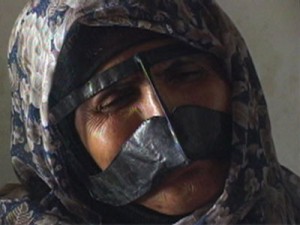 On the southern Iranian island of Qeshm in the Persian Gulf, women wear a headscarf, but also a “burka,” a pinching mask of black bands pressing against the eyebrows and nose, and ending in a point just above the mouth. The interviewed women do not remove this outward sign of oppression, but against the strict religious rules, they talk openly into the camera about their emotional problems, mental conditions and physical complaints. “We never wanted to appear before a camera, but now we do. We may wear a burka, but we are human beings. We breathe and live.”
On the southern Iranian island of Qeshm in the Persian Gulf, women wear a headscarf, but also a “burka,” a pinching mask of black bands pressing against the eyebrows and nose, and ending in a point just above the mouth. The interviewed women do not remove this outward sign of oppression, but against the strict religious rules, they talk openly into the camera about their emotional problems, mental conditions and physical complaints. “We never wanted to appear before a camera, but now we do. We may wear a burka, but we are human beings. We breathe and live.”
During a special ceremony called Zar (which means possession), different afflictions of the women can be treated. When there is no camera around, their only possible cry of distress is often death. So the film begins with the funeral of Samireh, who hanged herself from the fan with her shawl. “A woman is like a pair of shoes,” her grieving husband says. “When one is gone, you can find another one. But what am I supposed to do with the children?” Both men and women make lasting statements in the film, just as filmmaker Mehrdad Oskoui does by filming shots of the daily, barren life on the island, which is plagued by draughts and other catastrophes.
Please note: if no air times are listed, this program is currently not scheduled. Please check back again in the coming weeks.
LEARN MORE:
Millennium Campaign
InterAction – American Council for Voluntary International Action
The ONE Campaign












